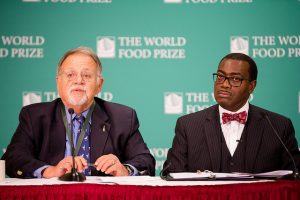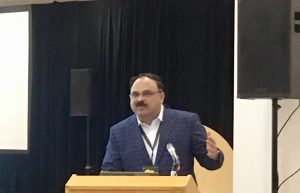
DES MOINES, Iowa (CIMMYT) – World Food Prize laureates have joined forces with an international alliance battling the fall armyworm (Spodoptera frugiperda), an aggressive pest indigenous to the Americas with a voracious appetite, now widespread throughout Africa.
The 2002 World Food Prize laureate, Pedro Sanchez, currently a research professor at the University of Florida, addressed delegates at the Borlaug Dialogue conference in Des Moines, Iowa, which is timed each year to coincide with annual World Food Prize celebrations.
Sanchez described the severity of the challenge posed by the pest, which has a host range of more than 80 plant species, including maize, a staple food on which millions of people throughout sub-Saharan Africa depend for their food and income security.
Fall armyworm activities not only put food security, livelihoods and national economies at risk, but also threaten to undo recent hard-earned crop production gains on the continent, Sanchez said.
“Hopefully, it will be controlled; it will never be eradicated,” Sanchez said. “I think the fate of African food security really hinges now on this clear and present danger. It threatens to reverse the gains achieved in the last 10 years. It’s the epitome of an invasive species.”
The pest, which has no known natural predators, can cause total crop losses, and at advanced larval development stages can be difficult to control even with synthetic pesticides. The female fall armyworm can lay up to a thousand eggs at a time and can produce multiple generations very quickly without pause in tropical environments. The moth can fly 100 km (62 miles) a night, and some moth populations have even been reported to fly distances of up to 1,600 kilometers in 30 hours, according to experts.
Sanchez said that Akinwumi Adesina, 2017 World Food Prize laureate and president of the African Development Bank, and Rob Fraley, 2013 World Food Prize laureate and chief technology officer at Monsanto, had united with him to urgently “raise the alarm” about the threat from the pest.
By joining forces as laureates, we aim to really bring attention to this issue to avoid a food crisis, Adesina said. Mobile phones should be effectively used in the fight against the pest, he said.
“There’s just no better way in which farmers can detect, recognize and send information very fast to extension agents or universities that can allow them to identify it and get the information they need to deal with it,” he said, adding that the new African Development Bank initiative Technologies for African Agricultural Transformation (TAAT), will play a key role in fighting the fall armyworm.
Projections by the Centre for Agriculture and Biosciences International, (CABI), indicate that if left unchecked, the fall armyworm could lead to maize yield losses of around $2.5 to $6.2 billion a year in just 12 of the 28 African countries where the pest has been confirmed.
Joint force
In April, the International Maize and Wheat Improvement Center (CIMMYT), the Food and Agriculture Organization of the United Nations (FAO) and the Alliance for a Green Revolution in Africa (AGRA) hosted an international joint stakeholders meeting in Nairobi, committing to an integrated pest management strategy to tackle the pest.
CIMMYT, the U.S. Agency for International Development (USAID), and experts from several national and international research organizations, are currently developing a detailed field manual on Fall Armyworm management in Africa, said B.M. Prasanna, director of the Global Maize Program at CIMMYT and the CGIAR Research Program on Maize, who spoke at a Borlaug Dialogue side event with a panel of scientific experts.

“The manual will offer protocols and best management practices related to fall armyworm scouting, monitoring and surveillance; biological control; pesticides and pesticide risk management; host plant resistance; pheromones and sustainable agro-ecological management of fall armyworm, especially in the African context,” Prasanna said, adding that the pest has so far devastated at least 1.5 million hectares of maize in just six countries.
A Southern Africa Regional Training-of-Trainers and Awareness Raising Workshop on Fall Armyworm management was conducted in Harare, Zimbabwe, from Oct. 30 to Nov. 1, while a similar workshop for Eastern Africa is scheduled for Nov. 13 to 15 in Addis Ababa, Ethiopia, and for West Africa in early 2018.
The workshops are aimed at supporting pest control and extension actors to effectively scout, determine the need for intervention, and apply specific practices to control the pest in maize and other crops, Prasanna said.
Fall armyworm toolbox
Prasanna announced that the CIMMYT team in Africa is intensively evaluating maize germplasm for resistance to fall armyworm. Initial experiments have indicated some promising breeding materials, which need to be validated further and utilized in product development and deployment pipelines, he said.
“The crisis is quickly escalating due to the loss of quality maize seed in production fields, and the extensive and indiscriminate use of low cost highly toxic pesticides,” Prasanna said.
“We need to quickly bring awareness among the farming communities in Africa about environmentally safer approaches of Fall Armyworm management,” he said, adding that the international community can learn from the experiences of Brazil and the United States, where the pest has been endemic for several decades.
“Sustainable agro-ecological management at the field and landscape levels is key,” Prasanna said. “We must make our solutions affordable to smallholder farmers.”
Panelist Mark Edge, director of collaborations for developing countries at agrochemical and biotechnology company Monsanto, said that integrated pest management, collaboration and public-private sector partnerships would be key to fighting the pest.
“First and foremost, it really is about an integrated pest management system – we’re not trying to propose that biotechnology is a silver bullet for this,” he said. “We need to continue to use many different technologies and biotechnology is one very powerful tool that we have in the toolbox.”
Over the past 10 years, the Water Efficient Maize for Africa (WEMA) a Monsanto-CIMMYT partnership project funded by the Bill & Melinda Gates Foundation and USAID has led to the development of almost 100 hybrid varieties effective against drought and a Bt – or biological pesticide – trait effective against the maize stem borers (Chilo partellus and Busseola fusca). The varieties will be available royalty-free to smallholder farmers.
“Insect resistance together with drought is our target; we’ve made tremendous progress over the past 10 years,” Edge said. “In the Americas, we still have challenges with fall armyworm, but we’re certainly able to control it to where farmers are actually able to get very good yields and manage the pests very effectively.”
Smallholder farmers need access to these varieties as soon as possible, so the focus should be on getting regulatory approvals in place by encouraging governments to support the technology, Edge said. The Bt trait varieties will need to be managed carefully so they do not develop resistance to the pest, he added.
“Scientists alone are not going to carry the day on this,” Edge said. “We need to bring together the science on this, but we also need the political will to help make that happen.”
Panelist Segenet Kelemu, director general of the International Institute of Insect Physiology and Ecology (ICIPE), said that techniques used to fight the stem borer have proven effective against the fall armyworm, although experiments are ongoing to craft an integrated pest management strategy to control various stages of the pest from egg to moth. The continent will face deepening challenges from insects due to climate change, she said.
“If there were capacity on the ground, fall armyworm would have been identified sooner,” Kelemu said. “We need a more comprehensive way and a global partnership to tackle this.”
Panelist Gregg Nuessly, a pest management researcher and the director of the Everglades Research and Education Center at the University of Florida, said that the fall armyworm could be effectively controlled through an integrated pest management approach.
“Success in control is not only possible, it’s quite common in the Western Hemisphere,” Nuessly said.
Related stories:
Borlaug Dialogue delegates to discuss strategy for tackling fall armyworm in AfricaMulti-pronged approach key for effectively defeating fall armyworm in Africa
Zimbabwe enacts new strategy in fall armyworm fight
Global experts meet to develop fall armyworm emergency plan for Africa
Fall armyworm in Africa: quick and coordinated regional response required
Scientists tackle deadly fall armyworm infestation devastating Africa


 Innovations
Innovations